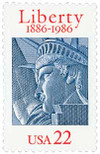
# 2224 - 1986 22c Statue of Liberty
U.S. #2224
1986 22¢ Statue of Liberty
- Issued for the 100th anniversary of the Statue of Liberty
- America’s 17th joint issue; second with France
Stamp Category: Commemorative
Value: 22¢, first-class rate
First Day of Issue: July 4, 1986
First Day City: New York City and Liberty Island
Quantity Issued: 220,725,000
Printed by: Bureau of Engraving and Printing
Printing Method: Engraved
Format: Panes of 50 in sheets of 200
Perforations: 11
Color: Scarlet and dark blue
Joint Issue: France #2014
Why the stamp was issued: To mark the 100th anniversary of the Statue of Liberty. It was issued a day after the newly renovated Statue of Liberty was unveiled. The stamp was proposed by French postal official Georges Laveau in November 1984 during a meeting at the Canadian National Stamp Exhibition on Montreal.
About the stamp design: The Statue of Liberty had appeared on 21 US postal items (as well as many stamps of other nations) prior to this stamp’s issue. Of those items, some showed the full statue and several pictured the head and shoulders or waist-up view. This stamp presented the most close-up view to date. Based on a photo, it shows the statue’s damaged nose, weather erosion, and copper sheeting use to form its face and arms.
The stamp was based on a photo by Peter B. Kaplan, known as the “preferred photographer of the Statue of Liberty.” He’d taken thousands of photos of the statue from more than 100 different angles during its renovation. He was known to climb skyscrapers, bridges, and other tall structures to capture seldom-seen shots. French artist Claude Jumelet created the engraving for both the US and France joint issue stamps.
Special design details: The France stamp appears darker than the US stamp. They were printed with the same ink, but the difference is in how the ink was wiped from the printing plates. The France stamp was printed on a press with a paper wipe, which is a paper roll that removes excess ink as the cylinders spin. The US stamps were printed on the D Press, which used a blade to remove the extra ink from the plates.
First Day City: The First Day ceremony for this stamp was held on Liberty Island on the Fourth of July. The ceremony was one of a number of events there that day, and despite a crowd of 20,000 people present, few were there for the stamps. The day’s events included a performance by the Coast Guard Band, a parade of tall ships, the US and French anthems, a performance of the Battle Hymn of the Republic, a speech by President Ronald Reagan, and a pyrotechnics show that filled the sky.
History the stamp represents: French politician and writer Édouard René de Laboulaye was one of the first to suggest giving America a gift to mark the centennial of the American Declaration of Independence. French sculptor Frédéric Bartholdi designed the sculpture and Gustave Eiffel (designer of the Eiffel Tower) designed the iron pylon and skeletal framework of the statue.
To fund the statue, the people of France made public donations. Performances were also used to raise money, including La liberté éclairant le monde (Liberty enlightening the world) by future famous composer Charles Gounod. In all, $250,000 was raised. Similarly, the U.S. – which had agreed to build the statue’s base – held several benefit events, art exhibitions, auctions and prizefights to raise money.
Although Laboulaye initially planned to present the statue to America in 1876, a late start and several delays made this impossible. The right arm and torch were completed in time, and were put on display at the Centennial Exposition in Philadelphia. The statue was completed in France in 1884 and shipped to America in 350 separate parts. It arrived in June 1886 and was reassembled while electricians worked on lighting the torch.
The last piece was riveted in place during the dedication ceremony on October 28, 1886. President Grover Cleveland presided over the ceremony and delivered a stirring speech:
“We are not here today to bow before the representation of a fierce warlike god, filled with wrath and vengeance, but we joyously contemplate instead our own deity keeping watch and ward before the open gates of America and greater than all that have been celebrated in ancient song. Instead of grasping in her hand thunderbolts of terror and of death, she holds aloft the light which illumines the way to man’s enfranchisement. We will not forget that Liberty has here made her home, nor shall her chosen altar be neglected. Willing votaries will constantly keep alive its fires and these shall gleam upon the shores of our sister Republic thence, and joined with answering rays a stream of light shall pierce the darkness of ignorance and man’s oppression, until Liberty enlightens the world.”
The dedication ceremony was followed by a fireworks display and New York City’s first ticker tape parade. The 151-foot copper statue was modeled in a classic Roman style based on Libertas, the ancient Roman goddess of freedom from slavery, oppression, and tyranny. The crown of seven spikes represents the Seven Seas and the seven continents, while the torch symbolizes enlightenment. Lady Liberty holds a tablet that is representative of knowledge, and reads “July 4, 1776,” the date of the Declaration of Independence.
Historians debate who Liberty’s face is modeled after, but it’s likely one of two women. Some believe it was Isabella Eugene Boyer, the recently widowed wife of Isaac Singer, creator of the Singer sewing machine. Others believe the statue was modeled after sculptor Frédéric Bartholdi’s mother, Charlotte Bartholdi.
U.S. #2224
1986 22¢ Statue of Liberty
- Issued for the 100th anniversary of the Statue of Liberty
- America’s 17th joint issue; second with France
Stamp Category: Commemorative
Value: 22¢, first-class rate
First Day of Issue: July 4, 1986
First Day City: New York City and Liberty Island
Quantity Issued: 220,725,000
Printed by: Bureau of Engraving and Printing
Printing Method: Engraved
Format: Panes of 50 in sheets of 200
Perforations: 11
Color: Scarlet and dark blue
Joint Issue: France #2014
Why the stamp was issued: To mark the 100th anniversary of the Statue of Liberty. It was issued a day after the newly renovated Statue of Liberty was unveiled. The stamp was proposed by French postal official Georges Laveau in November 1984 during a meeting at the Canadian National Stamp Exhibition on Montreal.
About the stamp design: The Statue of Liberty had appeared on 21 US postal items (as well as many stamps of other nations) prior to this stamp’s issue. Of those items, some showed the full statue and several pictured the head and shoulders or waist-up view. This stamp presented the most close-up view to date. Based on a photo, it shows the statue’s damaged nose, weather erosion, and copper sheeting use to form its face and arms.
The stamp was based on a photo by Peter B. Kaplan, known as the “preferred photographer of the Statue of Liberty.” He’d taken thousands of photos of the statue from more than 100 different angles during its renovation. He was known to climb skyscrapers, bridges, and other tall structures to capture seldom-seen shots. French artist Claude Jumelet created the engraving for both the US and France joint issue stamps.
Special design details: The France stamp appears darker than the US stamp. They were printed with the same ink, but the difference is in how the ink was wiped from the printing plates. The France stamp was printed on a press with a paper wipe, which is a paper roll that removes excess ink as the cylinders spin. The US stamps were printed on the D Press, which used a blade to remove the extra ink from the plates.
First Day City: The First Day ceremony for this stamp was held on Liberty Island on the Fourth of July. The ceremony was one of a number of events there that day, and despite a crowd of 20,000 people present, few were there for the stamps. The day’s events included a performance by the Coast Guard Band, a parade of tall ships, the US and French anthems, a performance of the Battle Hymn of the Republic, a speech by President Ronald Reagan, and a pyrotechnics show that filled the sky.
History the stamp represents: French politician and writer Édouard René de Laboulaye was one of the first to suggest giving America a gift to mark the centennial of the American Declaration of Independence. French sculptor Frédéric Bartholdi designed the sculpture and Gustave Eiffel (designer of the Eiffel Tower) designed the iron pylon and skeletal framework of the statue.
To fund the statue, the people of France made public donations. Performances were also used to raise money, including La liberté éclairant le monde (Liberty enlightening the world) by future famous composer Charles Gounod. In all, $250,000 was raised. Similarly, the U.S. – which had agreed to build the statue’s base – held several benefit events, art exhibitions, auctions and prizefights to raise money.
Although Laboulaye initially planned to present the statue to America in 1876, a late start and several delays made this impossible. The right arm and torch were completed in time, and were put on display at the Centennial Exposition in Philadelphia. The statue was completed in France in 1884 and shipped to America in 350 separate parts. It arrived in June 1886 and was reassembled while electricians worked on lighting the torch.
The last piece was riveted in place during the dedication ceremony on October 28, 1886. President Grover Cleveland presided over the ceremony and delivered a stirring speech:
“We are not here today to bow before the representation of a fierce warlike god, filled with wrath and vengeance, but we joyously contemplate instead our own deity keeping watch and ward before the open gates of America and greater than all that have been celebrated in ancient song. Instead of grasping in her hand thunderbolts of terror and of death, she holds aloft the light which illumines the way to man’s enfranchisement. We will not forget that Liberty has here made her home, nor shall her chosen altar be neglected. Willing votaries will constantly keep alive its fires and these shall gleam upon the shores of our sister Republic thence, and joined with answering rays a stream of light shall pierce the darkness of ignorance and man’s oppression, until Liberty enlightens the world.”
The dedication ceremony was followed by a fireworks display and New York City’s first ticker tape parade. The 151-foot copper statue was modeled in a classic Roman style based on Libertas, the ancient Roman goddess of freedom from slavery, oppression, and tyranny. The crown of seven spikes represents the Seven Seas and the seven continents, while the torch symbolizes enlightenment. Lady Liberty holds a tablet that is representative of knowledge, and reads “July 4, 1776,” the date of the Declaration of Independence.
Historians debate who Liberty’s face is modeled after, but it’s likely one of two women. Some believe it was Isabella Eugene Boyer, the recently widowed wife of Isaac Singer, creator of the Singer sewing machine. Others believe the statue was modeled after sculptor Frédéric Bartholdi’s mother, Charlotte Bartholdi.










